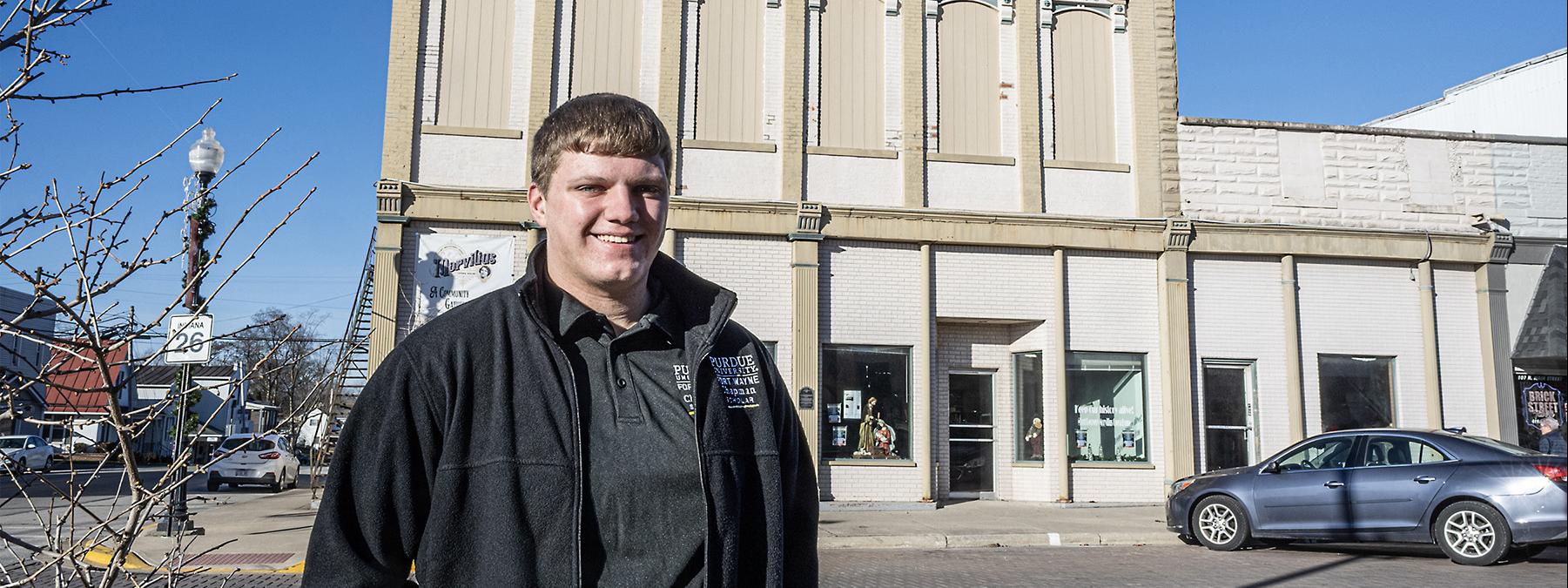




Mechanical engineering major at Purdue Fort Wayne steps up to help hometown project
By Blake Sebring
January 31, 2024
In the early stages of a push to renovate the Fort Recovery Morvilius Opera House in Fort Recovery, Ohio, Tracy Evers-Westgerdes was serving as the restoration group’s vice president. The structure was built downtown in 1883 at the whopping price of $5,000 to $6,000. It sat unused for 80 years, in such disrepair that no one wanted to buy it. The restoration group formed in 2020, estimating the project would require at least $2 million, with hopes of a reopening date in 2026.
Though only halfway through his first semester as a freshman, Purdue University Fort Wayne’s Caleb Evers knew he didn’t have a choice when his mother asked for a favor. Still, the mechanical engineering major wasn’t exactly sure he was capable of pulling it off.
One of the first goals was to repaint the second-floor ceiling where the auditorium is housed, but parts quickly began to crumble after removing two layers of wallpaper. Pictures and hand-written notes were taken, but the painters needed something more detailed to work from. That’s when Evers-Westgerdes texted her son.
As Evers describes it, he was halfway volunteered and halfway drafted. If he were married, it would fall under the definition “voluntold.”
“She very lightly hinted that I should do this,” Evers recalled with a smile.
While in the middle of taking a computer-assisted design class with Rebecca Essig, associate professor of engineering, Evers understood the theory of deciphering the geometric squares and translating them into a formal blueprint, but had never tried it.
“It probably took me a little longer than it should have because I wasn’t super-good at it and I was still figuring it out,” Evers said. “I’m glad I was able to put to good use what I was learning for a good cause. I was like, `I’m not just learning it, I can actually use it.’ It was definitely a good realization for me.”
Like many freshmen, Evers said he was wondering at the time if he had selected the correct major—and if his abilities were strong enough to support the efforts at the opera house.
“My biggest reluctance was I wasn’t super-confident I was the best person for it,” he said. “It was the first big project I had ever done. Once I saw on paper what it was they wanted me to do, then I realized I could do it because it was very similar to what my professor was giving me in class.
“When I did this, I was like, `I can actually do this, and I really enjoy doing this. This is the major for me.’ Turns out I was right.”
Over the 2022 fall break weekend, Evers needed about nine hours to complete the project. As a Chapman Scholar, he is also required to engage in community service, so the project fit those goals.
Last spring, painters took his design to produce a remarkable result, so vibrant and colorful that organizers are showing the painting to prove the legitimacy of their vision for the overall project. Instead of simply relying on an artist’s projected renderings, they can showcase the actual completed work.
“It was very important because it helped the painters,” said Kim Rammel, president of the restoration group. “They took this drawing up there to paint all of this by hand. It took them six weeks, and without this, it would have been much tougher.”
When his mother sent him pictures of the final product, an excited Evers jumped almost high enough to hit his head on his ceiling fan in student housing.
“When I grow up and eventually have a family and this is up and running, I’ll be able to show my kids that I was part of it,” Evers said. “I figured this would at least be a good learning experience, good practice, but it turned out really well.”
In the meantime, organizers said they continue looking for Evers’ next “voluntold” project.




